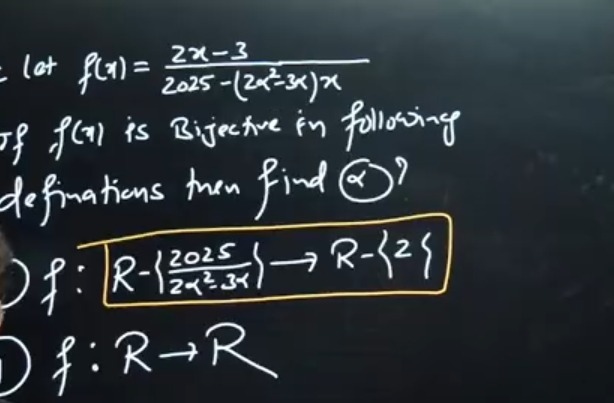Question
Question: Let $f(x) = \frac{2x-3}{2025-(2\alpha^2-3\alpha)x}$. If $f(x)$ is Bijective in the following definit...
Let f(x)=2025−(2α2−3α)x2x−3. If f(x) is Bijective in the following definitions then find α?
-
f:R−{2α2−3α2025}→R−{2}
-
f:R→R

For definition 1, α∈{1,21}. For definition 2, α∈{0,23}.
Solution
A rational function of the form f(x)=cx+dax+b is bijective if ad−bc=0. If c=0, the domain is R−{−cd} and the range is R−{ca}.
Let K=2α2−3α. Then f(x)=2025−Kx2x−3. Here a=2, b=−3, c=−K, d=2025. The injectivity condition is ad−bc=(2)(2025)−(−3)(−K)=4050−3K=0.
Case 1: f:R−{2α2−3α2025}→R−{2} For the domain to be R−{K2025}, we must have K=0. The range of a rational function is R−{ca}. In this case, the range is R−{−K2}. For the function to be surjective onto R−{2}, the range must be R−{2}. Therefore, −K2=2, which implies −2=2K, so K=−1. Substituting K=2α2−3α: 2α2−3α=−1 2α2−3α+1=0 Factoring gives (2α−1)(α−1)=0. So, α=1 or α=21. For these values, K=−1=0, which is consistent with the domain definition. The injectivity condition 4050−3K=4050−3(−1)=4053=0 is satisfied. Thus, for definition 1, α∈{1,21}.
Case 2: f:R→R For the domain to be R, the denominator 2025−Kx must never be zero for any x∈R. This occurs if and only if the coefficient of x is zero, i.e., K=0. 2α2−3α=0 Factoring gives α(2α−3)=0. So, α=0 or α=23. If K=0, the function becomes f(x)=20252x−3, which is a linear function with a non-zero slope. Linear functions with non-zero slopes are bijective from R to R. Thus, for definition 2, α∈{0,23}.
